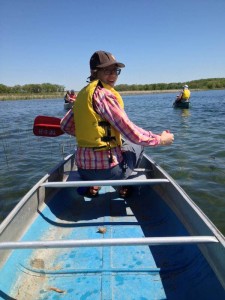Way back in April, when we registered for the SFS conference, I was surprised and excited to see my hometown of Mukwonago, WI listed among the field trips. Joanna and I signed up, and after a tiring but successful week of networking and learning about the work of other freshwater scientists, we were on a school bus headed to the Mukwonago River watershed.
 Our first stop was Lulu Lake, a preserve held by The Nature Conservancy as part of a network of protected land in the Mukwonago River Watershed. TNC works in this area both to protect terrestrial and aquatic habitat. Through manual weeding and controlled burning, TNC manages oak savanna that would otherwise become choked wi
Our first stop was Lulu Lake, a preserve held by The Nature Conservancy as part of a network of protected land in the Mukwonago River Watershed. TNC works in this area both to protect terrestrial and aquatic habitat. Through manual weeding and controlled burning, TNC manages oak savanna that would otherwise become choked wi th shrubs and invasive weeds. The preserves also help protect water quality in the river, which serves as habitat for more species of fish and mussels than any other similar sized river in the state of Wisconsin.
th shrubs and invasive weeds. The preserves also help protect water quality in the river, which serves as habitat for more species of fish and mussels than any other similar sized river in the state of Wisconsin.
After learning about the goals and management of Lulu Lake Preserve, we went back out into the warm, cloudless spring day to explore the lake and marsh by canoe. The 15 of us canoed up the small, winding stream feeding into the lake, discussing ecology and collecting aquatic insects. We listened to pairs of sandhill cranes chortle as we struggled to maneuver our canoes through the narrow channels.
When we got off the water, we stopped for the classic Friday meal in Wisconsin: fish fry, before heading to Lapham Peak State Park. We walked to the top of the observation tower to get a wider view of the lake-pocked glacial landscape we’d explored earlier by foot and canoe (as I heard one fellow attendee remark, “Wow! It’s flat!”). The park and its eponymous “peak” (that’s a hill, for you folks from places with topographic relief) take their names, in turn, from Increase A. Lapham. Lapham was a scientist and naturalist, founding the Wisconsin Natural History Society in 1848 (the same year Wisconsin gained statehood). More notably, perhaps, Lapham was responsible for spurring Congress to create the National Weather Service in 1870.
All in all, the field trip was a great way to relax (but keep riding the nerd train) after the SFS 2015 conference. I was shocked that I hadn’t known about the rich biodiversity of the Mukwonago River growing up there – I had only driven over the river to get to the freeway, not knowing about the species that thrived there under the bridge until I came back 10 years later.
